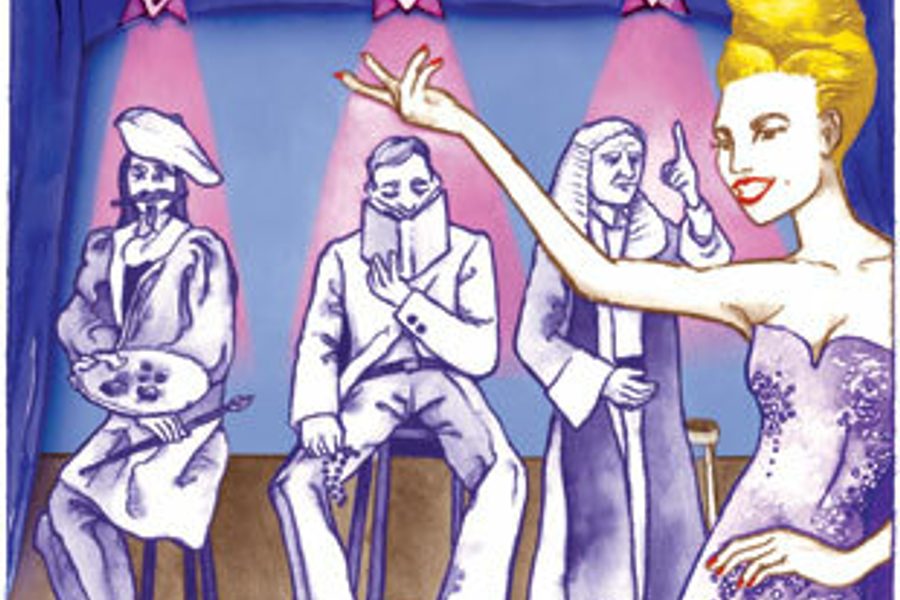
While rereading the poetry of William Blake recently, I realized very little had changed between the 18th century and today. Of course, the media would like us to believe that the zeitgeist spins madly, producing “eras” as if they were products being readied for the next marketing season (which is exactly what they are). The media doesn’t want you clinging to any antique notion of “who we are” any more than the auto industry wants you to cling to your 1990 Civic. And so we have the Sixties, the Me Generation, Reagan’s Yuppies and Gen X. The Cold War, the War Against Terror, the Clash of Civilizations and Globalization. This approach to understanding national identity and history is as dizzying and malevolent as that possessed girl’s spinning head in The Exorcist.
What no one wants us to imagine is that the fundamentals of identity have not changed dramatically in 250 years. And it could be that even that estimate accelerates the matter. For William Butler Yeats, meaningful historical epochs last 2,000 years. We’ve only just recently emerged from the second, “Christian,” era.
For poets like Blake and Yeats, history is a long, grinding affair. Change is almost imperceptible. Reading Blake revealed that however much the details have changed, the big picture is much as it was in 1783 when Blake published his first book of poetry. The three principal ideological elements in Blake’s time were the backward-looking forces of Christianity, the Enlightenment advocates of Reason and Experience, and the revolutionary practitioners of the Imagination: In short, Christians, rationalists and poets.
Without question, the dominant ideology since 1783 has been the rationalist. For Blake, the “manacles” of industrialization were “mind-forged” by what he called Ratio — the tendency to divide the world from the self, the human from the natural, the inside from the outside and the outside itself into ever finer degrees of manipulable parts.
In spite of its domination, Ratio has always felt it necessary to continue its criticism of religion, or “superstition,” and obliged to defend itself from the criticisms of its post-Enlightenment sibling, the Imagination. Ratio’s debate with these two competing tendencies has been taken up in great detail and energy in two recent books, both of which share at least one virtue: They understand that our problems are essentially the problems that confronted William Blake.
Susan Jacoby’s Freethinkers: A History of American Secularism is a useful tonic for a moment in which religious fundamentalism seems to own all political leverage. Conservative politicians kowtow to the evangelists, and even the most liberal candidates must carefully nuance their positions so as not to appear insensitive to fundamentalism’s primary concerns with “values”: orthodox piety, school prayer, abortion and gay marriage.
Jacoby’s useful response to this slowly evolving national disgrace is to show that the present culture wars over value (our red state/blue state standoff) is not a recent development and is not merely the consequence of a cultural backlash over the aberrant ’60s. Our culture war is, rather, a disagreement, an enmity, that is fundamental to our national character. The deistic freethinking and respect for Reason typical of figures like Thomas Paine and Thomas Jefferson was from the very first in conflict with the assumptions of evangelicals. Jacoby reminds us in revealing detail how this tension between the Enlightenment’s reverence for Reason and Protestantism’s confidence in revelation have played out in national controversies from the abolition movement to the teaching of evolution to women’s suffrage and the civil rights movement.
On the other hand, Nicols Fox’s Against the Machine: The Hidden Luddite Tradition in Literature, Art, and Individual Lives attacks the smug assumptions of Reason from the perspective of Blake’s Imagination. For Fox, too, the present conflicts over the role of reason, science, technology, and the mechanization of the human and natural worlds is an old story, one she tells with great energy and knowledge. For Fox, the digitalization of the world is only the latest version of the problem first confronted by the Luddites: the end of the world of human creativity and the beginning of the world as human machine. Her survey of the opposition provided by the Luddites, Romantic poets like Blake and Percy Bysshe Shelley, early critics like Charles Dickens, Thomas Carlyle, and John Ruskin, and the utopian efforts of William Morris and the Arts and Crafts movement is fascinating and inspiring.
Useful though these two books are for reminding us how little the media’s chatter about change really gets to the enduring essentials, there is an interesting paradox in them. The books themselves — their form, their rhetoric, their approach to argument, their assumptions about what they can expect of their readers — are an acknowledgment of the continuing domination of Blake’s Ratio. As much as I admire Fox’s book, I wouldn’t call it a work of the imagination.
Fox articulates what’s wrong with utilitarianism: It separates “individuals not only from nature but from their own natures — from the creative, imaginative, and spiritual aspects of human existence.” And yet my feeling is that Fox’s book, and certainly Jacoby’s, is finally utilitarian. They are books of popular history and social commentary written by professional journalists. The prose, the approach to structure and argument are very familiar, are industry standard, if you will. Fox admires Ruskin for writing books in which “Divisions between topics are artificial constructs; one thought naturally leads to another, and it may or may not be the topic he began with. The reader must follow and put aside impatience for the pleasure of digression.”
Well and good, but this is not a description of Fox’s book, though it’s no fault of her own. If she had written a rambling meditation full of quirky genius and digression, she would have been violating her own disciplinary training and she would probably never have found a publisher.
Innocent though Fox may be, I think this irony cuts deep. Her thematic critique of Ratio is in a form that Ratio tolerates because it tends implicitly to confirm its own reign. Unfortunately, the Ruskins of the present are mostly unpublishable if not, as critics like to say, “unreadable.” For these critics, digression is “self-indulgent.” Works in Ruskin’s spirit fail the rationalist test of clarity, of perfect transparence. This test, let it be known, is finally only about ideology. History and criticism written by journalists in a journalistic mode is unwittingly utilitarian in that it, too, seeks “the greatest good for the greatest number.” In matters of art and intellect this is only a brush stroke away from “dumbing down.” (“There is no audience for this stuff!” say the nice people in marketing. The nice people in editorial then go slinking off full of contrition.) In such subtle yet fatal ways we lend comfort to those we call enemy.

I hope you found this article important. Before you leave, I want to ask you to consider supporting our work with a donation. In These Times needs readers like you to help sustain our mission. We don’t depend on—or want—corporate advertising or deep-pocketed billionaires to fund our journalism. We’re supported by you, the reader, so we can focus on covering the issues that matter most to the progressive movement without fear or compromise.
Our work isn’t hidden behind a paywall because of people like you who support our journalism. We want to keep it that way. If you value the work we do and the movements we cover, please consider donating to In These Times.





